Julia Brannan's Blog
August 26, 2024
Scottish Folk Tales (Part Four)
Here’s another (and probably my last) folk tales blog, although I am intending to include more folk tales in my monthly newsletters.
A TALE FROM GREYFRIARS KIRKYARD, EDINBURGH
The graveyard at Greyfriars Kirk is a really interesting and atmospheric place to visit, and abounds with stories of hauntings. There are ghost tours of the city that include the graveyard, and a tale often told is one of Sir George Mackenzie, whose mausoleum is in the kirkyard.

Sir George Mackenzie
He was appointed as Lord Advocate by the king and took part in the brutal suppression of the rebel Covenanters in the late 17th century. The Covenanters rebelled against the established church, and in 1679 were comprehensively defeated in a battle called Bothwell Brig. Several thousand Covenanters refused to swear allegiance to the king, and were imprisoned in a small area of Greyfriars Kirkyard. Over the winter months, as well as suffering from the extremely bitter whether, which killed some of them, as the area they were imprisoned in was outdoors, numbers of them were beheaded, tortured, transported and starved, at the behest of Mackenzie. It’s not surprising that he was nicknamed ‘Bloody Mackenzie’ by them, a name that has stuck.
When he died he was buried in the same kirkyard the prisoners had been held in, and in which many of them were also buried, having failed to survive their imprisonment. It was said that he died ‘wasted by fountains of blood continually issuing from all parts’, which was held to be proof of divine punishment for his brutality.
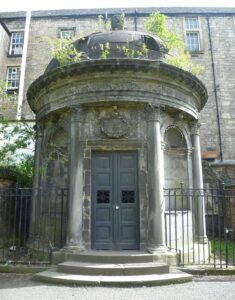
The Mackenzie Mausoleum (Att: Kim Traynor)
It seems that in spite of all this his spirit rested. In spite of mischievous schoolboys in the nineteenth century knocking on his tomb and inviting him to come out if he dared, he didn’t oblige them. His tomb was once used as a hiding place by a boy on the run from the police. His friends brought him food until he could get passage on a ship and escape. He was presumably more afraid of his sentence than of lying with the desiccated corpse of the brutal tormentor!
All stayed quiet, until in 1998 a homeless man broke into the mausoleum. He ransacked the tomb, which holds a number of bodies as well as Mackenzie’s, and broke open a number of the caskets, possibly hoping to find jewellery buried with the corpses. While trying to open one of the caskets, the floor gave way and he fell into one of the plague pits which was beneath the mausoleum. It was full of the bodies of plague victims, and due to the conditions, many of them had not rotted away completely. Horrified by the number of bodies, and the stench, the man ran screaming from the mausoleum and wasn’t seen again.
The following day a woman was blasted off the steps by a cold force as she tried to peep inside the mausoleum, and soon after another woman was found unconscious at the entrance, covered in bruises and partially strangled. Since then there have been hundreds of sightings of ghostly attacks on people visiting the tomb, and it’s now said that Mackenzie’s ghost, released by the homeless man, is responsible for the attacks.
THE THISTLE OF SCOTLAND
This looks at the reason why the thistle, another enduring emblem of Scotland, became the national flower (apart from the fact that it grows everywhere!) Some people say that it’s a good metaphor for the country, which is extremely beautiful, but can be cruel and heartless to anyone treating it without respect. There are a number of theories as to how it became our flower.

Scottish thistle
One of these says that it’s because the spear-like shape of its leaves is reminiscent of the ranks of spears the Scots used in battle. I find this a little shaky, as many armies would have used spears at one time. Another story states that in the 11th century when the Danes invaded the Highlands, they tried to sneak up on the Scots silently, by walking barefoot. However, when they had to walk across a field of thistles, their cries of pain alerted the enemy, who attacked and beat them as a result.
Another story, dating even further back to the 10th century, when the Norse were raiding rather than trying to settle, it’s said that a raiding party planned to attack a castle at midnight by swimming across the moat and sneaking in. But when they took off their clothes and dived in they discovered that the moat was full of thistles rather than water, which had been placed there in case of such an attack. The cries of the Norsemen alerted the Scots, who repulsed the enemy.
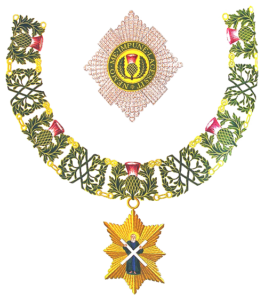
Order of the Thistle insignia
There are a number of types of thistle, but the one assumed to be the Scottish thistle is the spear thistle (Cirsium Vulgare). It is extremely prickly, and if you have ever stood on one in your bare feet (yes, I have), the barefoot Danes story suddenly becomes very plausible. It’s a tenacious plant with beautiful purple flowers, which later become a profusion of seeds topped by silky thistledown, which then are blown away by the slightest breeze, to take root elsewhere. Thistledown was once used to stuff bedding, as it’s very soft and fluffy. As the thistle on coats of arms is very stylised, we can’t be certain that the spear thistle is actually the original Scottish thistle – it’s just the most likely of a number of contenders. Whichever one it is, the thistle has been associated with the royal family of Scotland since the 1300s. It’s the badge of the House of Stuart, and there are coins showing the thistle from at least 1470. The highest order of chivalry in Scotland is the Order of the Thistle, which certainly existed by the time of King James V. The motto is ‘nemo me impune lacessit’ (no one provokes me with impunity), a prickly message which suits both the flower and the Scottish temperament!
SECOND SIGHT
In the Jacobite Chronicles I’ve mentioned the second sight a couple of times. My mother believed in it, with good reason, and I’ve heard a number of stories about unexplained sightings that have come to pass. The second sight is the ability to see things either at a distance as they’re happening, or before they’ve actually happened in time. It’s often said to be an inherited trait, and is usually not welcome to those who have it – understandable, as the visions the person so endowed had could be very distressing, and often not preventable.
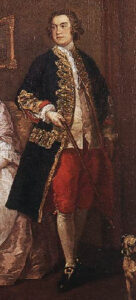
Nobleman in a new coat
One story told where a sighting did (partially) prevent a tragedy took place in the 17th century, when a nobleman was putting on a beautiful new coat when one of his companions begged him to remove it immediately, and not wear it, as he could see a dagger sticking in it. Rather than laughing at him, the nobleman took the advice, and took off the coat. A servant said he’d be happy to wear it, so the nobleman gave it to him. The poor menial was stabbed to death the same night.
Another story concerns a man named Alexander Brown from Balephuil, who said that he was walking along one day when he suddenly fell over, for no apparent reason. He got up, but within moments fell over again. Cursing himself for his clumsiness, he rose again and continued more carefully, but still fell a third time. This time when he got up he looked around, and saw the shadow of a woman standing next to him. He took a few steps, but then she seemed to touch his shoulder, on which he fell over again. Not being far from home now, he decided to crawl there on his knees, and although the shadow of the woman followed him, she didn’t touch him again. The next night he discovered that an old woman had died on a nearby farm, at the time he had seen the shadow causing him to fall. He was convinced that it was the dead woman who had walked with him on the previous evening.
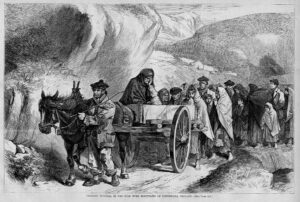
Poor person’s funeral
Another man told of a day when he was going home in a horse and cart, accompanied by an acquaintance. His horse was normally very well-behaved, but on this occasion when it was close to the local church, the horse suddenly stopped and wouldn’t move, no matter what her owner did. When the man said aloud that he had no idea what was wrong with her, his companion told him to wait a few minutes, and then asked him to try again. Now the horse walked on quite happily. When the owner remarked that he’d never seen her stand so stubborn and still for so long, his companion replied, “How could she go on, with a funeral passing us?” The horse owner had seen nothing, but his friend, who had the second sight, had clearly seen a phantom funeral, and the horse had either seen or sensed it, and had stopped.
July 1, 2024
Scottish Folk Tales (Part Three)
Seeing as people have really enjoyed my first two blogs about Scottish Folk Tales, here’s another one. There’s a tale about witches, one about the Devil, but the first one is a tale set at the time my books are set in. I hope you enjoy them!
A TALE FROM ANNANDALE, DUMFRIESSHIRE
This is a story which dates back to the time of my Jacobite Chronicles, which took place in the autumn of 1745. In Annandale there was a man called Adam Bell, who was a landowner. He was handsome, muscular, an excellent horseman and very proud of his skill as a swordsman, about which he used to boast to anyone who would listen.
In the autumn of 1745 he decided to go on a trip to Edinburgh, intending to stay there for a good time, leaving his housekeeper to take care of his house while he was away. A few days later, to her surprise he returned, dressed in the same clothes he’d left in, but when she asked him why he’d returned, and then if he wanted anything to eat or drink, he didn’t answer her. A few minutes later he left the house, and walked across the grounds, disappearing into the woods. When the housekeeper reported this strange behaviour, a search was made, but no one was found. Adam never returned to the house, and nothing more was ever heard of him, and eventually a relative took over his house and business.
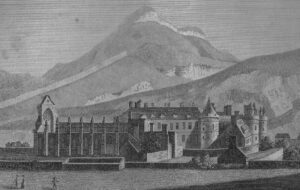
Holyroodhouse Edinburgh
At the same time the housekeeper was wondering why her master had returned, a farmer, who was staying on the Royal Mile in Edinburgh, near Holyrood House, was feeling quite ill, so he got up in the night, intending to get some fresh air, and went for a walk in the garden at the back of the house. All of a sudden he saw a tall man come into the garden, then walk up and down for a time, clearly impatient. After a while another, smaller man came into the garden, and the two proceeded to have an argument, which quickly turned into a fight. At first the tall man seemed to be winning, but then the moon suddenly went behind a cloud and he tripped and fell forward, upon which the shorter man ran him through immediately, killing him. After that he quickly left the garden.
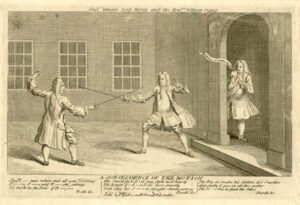
Duelling, 18th Century
The farmer decided not to say anything about what he’d seen, worrying that he might be accused of having a role in the murder, but the next day heard all about the dreadful deed, and that the dead man could not be identified, as he had no papers on him, and no one had seen him before.
Several years passed before the farmer heard about Adam’s mysterious disappearance, and convinced that he could solve the mystery, he finally revealed what he’d seen in Edinburgh. The identity of the murderer was never discovered, though.
Stories like this, of a person appearing elsewhere at the time of their death are quite common, and there is in fact such a story in my own family, which caused a pretty nasty family feud!
WITCHES
The last witch to be executed in Scotland was Janet Horne, an old woman who lived in Loth, in Sutherland. When younger she’d been a ladies’ maid, but when she grew old she became somewhat senile, and was looked after by her daughter, who had deformed hands and feet (possibly due to arthritis). As was the case with a number of senile or lonely old ladies at this time, her neighbours became suspicious of her, and she was accused of riding her daughter, who had been turned into a pony by the Devil. It was said that the daughter had not been turned back into a human properly, which was the reason why her hands and feet were so deformed.
Both women were arrested and pronounced guilty after a hasty trial. The daughter managed to escape, but when Janet was taken to the fire in Dornoch where she was to be burnt, it’s said that, it being a cold day, she warmed her hands by the fire, commenting that it was a bonny blaze, and cheerful to see so many neighbours gathered around. In Scotland witches were burned, but were usually strangled first. However this poor old lady was burned alive, having been placed in a barrel of pitch.

Dornoch in present times.
It seems really obvious to us now that she was clearly suffering from dementia, and was killed due to the ignorance and superstition of the local people (including the magistrate, who was later censured for his part in the proceedings), but humans always look for explanations for strange events, and didn’t have the medical or anatomical knowledge we now have. Many still thought of deformity or illness as a sign of evil, or of God’s punishment for sin.
Stories of witches riding people who’ve been turned into horses or donkeys go back at least to the 2nd century. Usually the victim accepts a gift of a magic bridle from the witch, or in some cases gifts of cheese and eggs. Witches were known to ride real horses as well as bewitched people on their nightly trips, and the sensation of pressure on the chest that people sometimes get when they’re having a nightmare was believed to be due to a witch sitting on their chest, which caused terrible dreams and left the victim tired.

Witch with her familiar, 1579
Following the passing of the Witchcraft Act in 1563, during sixteenth century and until Janet Horne’s death in 1727, over 4000 people were tried for witchcraft in Scotland, about half that number being sentenced to death. Anyone could be a witch, but the most common people accused were old ladies living alone, who had incurred the dislike of the community for some reason. They would then be suspected of causing any unexplained or sudden misfortune. Under torture many would confess to all sorts of outlandish crimes, and would sometimes name others in an attempt to escape the torture. The Act was finally repealed in 1736 (as I mention in The Ladies’ Tale).
It must have been a horrific experience for the victims, who were no doubt guilty of nothing more than being eccentric, cantankerous or possibly suffering from dementia. A very sad part of our past, but one that should be remembered, if only to show how cruel it is to condemn others merely for being different.
A DEAL WITH THE DEVIL
This story comes from Changue Forest, in Ayrshire. In the eighteenth century there used to be a fair held there every year, which drew country people from all over the country. In those days there were not many rural entertainments, and people lived more isolated lives, so an opportunity for a mass gathering was always welcomed. At the fair would be food and drink, entertainers, including singers and fortune-tellers, traders selling all manner of things, and there would also be music, and at the end of the evening, organised fights.
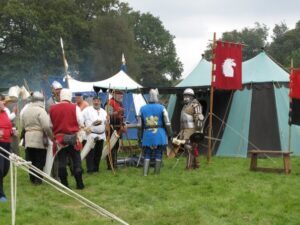
A country fair held in my village in Wales
The Laird of Changue was renowned for his courage and strength, and his performance in the fights at the fairs was remembered for years afterwards, because he was so formidable. He was also a brewer, and a smuggler of whisky, and hid his still in the hills where no one could find it.
People said that at some point he sold his soul to the Devil, and after that he always had good luck. He was never apprehended by the excisemen, all his smuggling ventures went well, and he became very rich and prosperous. In time the laird all but forgot about his bond with the Devil, and was just enjoying his wonderful life.
However, the Devil never forgets, and so it was that one night he came upon the laird in a lonely place and told him that it was time for him to pay his debt. The laird might have forgotten his pact, but he had not forgotten how to fight, so he drew his sword and challenged the Devil to a duel, first of all drawing a circle round the spot where they stood with his sword. The Devil did everything he could to drive the laird out of the circle, because he knew that it was a protective circle, and if he could throw the laird out of it, he could claim the soul. But if the laird threw the Devil out of the circle, he would have to return to Hell without the soul.
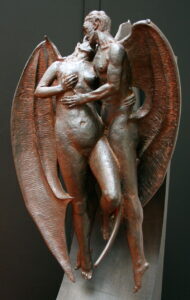
Statue of the Devil
The two of them fought for a long time, both of them determined to win, but in spite of all his tricks, the laird could not be pushed out of the circle. In the end the Devil lost his temper, and spreading his enormous wings and breathing fire he flew at the laird, sure he would now win. But at that moment the laird brought his sword down in a mighty blow, severing one of the Devil’s wings at the joint where it met the shoulder. Then he hit the Devil so hard in the mouth that he was knocked right out of the circle. At this, realising that he had met his match, the Devil gave in and returned to Hell, leaving the laird still in possession of his soul.
My next folk tales blog will include a tale from a very haunted place – Greyfriars Kirkyard in Edinburgh!
April 21, 2024
Scottish Folk Tales (Part Two)
Here’s the second part of my Scottish folk tales blogs. Telling stories is now often confined to bedtime stories for children, or to a tale at the end of a school day for little ones, but in the days before electricity, and when many people either couldn’t read or afford books, stories were a regular feature of entertainment all over the world. Some would be told by professional poets or bards, who would have the job of memorising the history of the people and then telling it in a heroic manner that complimented whoever they were telling it to. But stories were also told by ordinary people, and some of them were scary or warning stories, which entertained a group. Here are a few more that were told in Scotland.
THE WHITE LADY OF LITTLEDEAN TOWER
This story is linked to a tower in the Tweed Valley, which was the home of the Kers until the 18th century, when they moved to a more convenient location. There are the remains of a prehistoric fort on the site, so the area has certainly been occupied for many centuries.

Littledean Tower (Att: David Weinczok@TheCastleHunter
The site is said to be haunted by an old lady, who was at one time the mistress of the tower, but who seems to have been a Scrooge-like character, who particularly disliked the poor, and was very unkind to them. Being a miser, she’d accrued an enormous amount of money, and when she died, her spirit was so obsessed with this treasure that she couldn’t rest, so haunted the tower. The family who lived there at the time had never seen the ghost, but one evening a servant girl was alone in the kitchen cleaning the family’s shoes, when she saw a strange light shining in the corner, which became an old woman, who complained that she was very cold, and asked if she could warm herself by the fire.
The servant was a kind girl, and not only told the woman to warm herself, but also offered to dry and clean the lady’s shoes, which she’d noticed were wet and dirty. The woman was very touched by this kindness, and confessed to the girl that she was the ghost of the old mistress, and told her that the gold she’d amassed when alive was buried under the tower stairs, and instructed her to tell the laird of the tower to dig it up, and to keep half of it for himself, then give a quarter to the poor of the area, and a quarter to the servant girl who’d been so kind to her. She then said that if that happened, she would be able to rest in her grave.
It seems the laird was a decent person (or afraid of ghosts!) because he did as asked, and as a result of that the servant girl, now rich, found herself a good husband soon after (of course!) and the poor people all blessed the old lady who had made their lives so hard when she was alive.
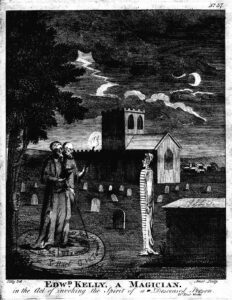
A magician raising a white lady
White lady ghost legends are found all over the world, and are often located in rural areas. Many of them have been murdered, or died in tragic circumstances, so this Scottish story is a little unusual, as there’s no mention of how she died, just that she needed to atone for her wicked life.
THE DEVIL AND SMOO CAVE
Smoo cave is in Durness. I’ve been there, and it’s an absolutely beautiful, peaceful place on the north coast of Scotland, which has a huge sea cavern, and this story relates to that. Sir Donald Mackay was born in 1591 and died in 1649 after an eventful life. He didn’t seem to be a particularly pleasant person, so it’s not that surprising that after his death he became known as a magician, who had struck a pact with the Devil. The Devil invited him to attend the Black School of Padua, but said that the last student to leave the session after his teaching would become his, as payment. Donald Mackay was the last to leave, but tricked the Devil into seizing his shadow instead of him, and managed to escape.

Entrance to Smoo Cave
When he got back to Scotland, everyone noticed that he had no shadow, and concluded that he’d been up to no good. The Devil, however, was not about to let matters lie, and so, one day when Mackay went to explore Smoo Cave, the Devil found out and was waiting for him there when he arrived. Exploring with his dog, Mackay had reached the second cavern, but his dog had gone ahead to the third, but came back howling, and completely hairless. This warned Mackay of who was waiting for him. Before he could decide what to do, dawn broke, and on hearing the cock crow, the Devil, along with the three witches who were with him realised they had to leave immediately, and blew huge holes in the roof of the cave to get away.

The Devil by Jacob De Backer
There are quite a few stories about people going into caves with dogs, including one I read some time ago about a piper who went exploring a cave – the dog returned with all its hair burnt away, but the piper was never seen again. The fiery encounter with the dog is a sure sign that the Devil is involved. These stories may have been told as a practical warning to children not to explore cave systems in the hope that the thought of meeting the Devil would put them off possibly getting lost or buried in a dark cave or shaft.
CHANGELINGS
The belief in fairies goes back a very long way in Celtic culture, and there are many stories about human encounters with fairy folk. I want to add that the fairies of Celtic legend are a very different creature to the gauzy-winged scantily dressed cartoon creatures you might be thinking of! It was widely believed that fairies would sometimes steal a human child that they took a fancy to, and when they did, would often leave one of their own in its place, which would take on the exact appearance of the stolen child. This is one story about such a happening, and took place in Kilchoman, on Islay, which is an island in the Inner Hebrides.
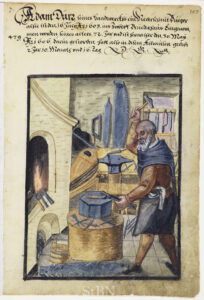
Sixteenth-century blacksmith
On the island lived a blacksmith by the name of MacEachern, who it seems was probably a real person, and a very accomplished smith. It’s said that he had only one child, a strong and healthy son who was very dear to him. But when the boy was about thirteen he suddenly fell ill and spent all his time in bed. He had a huge appetite, but even so, was wasting away, and became very thin. His father was understandably very worried, but no one could work out what might be wrong with the boy until one day a wise man told the smith that in his opinion the son had been stolen by the fairies, and a changeling left in his place.
He said that in order to be sure this child was a changeling, the smith had to collect a great many eggshells and spread them out in the child’s bedroom. Then he had to pretend they were full of water, carry them as though they were very heavy and arrange them round the fire. The smith was a little bemused by this, but did as he’d been told, on which the boy started laughing, and said that in his 800 years of life, he’d never seen such a sight before. This told the smith that the creature was indeed a fairy, but now he had to get rid of it and get his son back.
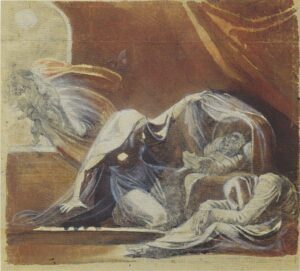
The Changeling by Füssli
He made another trip to the wise man, who told him to throw the changeling onto a large fire. The smith built up the fire in the middle of his little house and then threw the creature on to it, whereupon it gave a great howl and flew up to the roof, escaping through the hole that let the smoke out. After that, still following the wise man’s instructions, the smith went to a round grassy hill on the island, taking a Bible, his dirk and a cockerel with him. He waited for a while until he heard music and singing coming from inside the hill, upon which he entered the hill, sticking his dirk in at the threshold. The fairies were very angry at the intrusion, but they couldn’t hurt him because he was carrying a Bible, so they curtly asked him what he wanted. He replied that he wanted his son back, and wouldn’t leave until he got him. At first the fairies started laughing at the smith’s audacity, but the noise woke up the cockerel, which started crowing loudly, after which the fairies threw both the smith and his son out of the hill.
For about a year afterwards the son hardly spoke, and did no work at all, which is hardly surprising, if he was traumatised. But one day, while watching his father make a sword, he suddenly said ‘That’s not the way to do it!’ His father gave him the tools, and the boy made an exceptional sword, more beautiful than anyone had seen before. After that, father and son worked together, and soon became very rich and famous.
My next blog has three more folk tales, including one about witches.
February 25, 2024
Scottish Folk Tales (Part One)
There are many folk tales from various countries throughout the world, which would often be told as cautionary tales, moral lessons, or just to amuse people in a time before electricity, internet and TV, and when many people could neither read nor afford to buy books in any case. Such tales were a huge part of the social life of people, and in fact still are, although they tend to be directed more at children now, through books and films. But I think most of us have memories of being told or read ‘fairy stories’. So here are some from Scotland. I hope you like them.
THE SHOEMAKER
This is a story from Selkirk. In the distant past most people started work at dawn, and worked from dawn until dusk. This meant that in the winter, working hours could be very short. Where I live in Aberdeenshire at this time of year, it’s too dark to work without light by about 3.30pm, and sunrise isn’t until nearly 9.00am. If you didn’t work, you weren’t paid, so many people would start work before dawn, and work by candlelight. Shoemakers were among these, and this is the tale of a shoemaker.
Early one morning in the winter, a shoemaker was working in Selkirk. His shop was the nearest one to the church, and he was visited while it was still dark by a stranger. The stranger asked for a pair of shoes to be made for him, which were to be delivered at the same early time on a specific day. The shoemaker agreed, made the shoes, and the customer arrived at the right time, paid for the shoes and left with them.
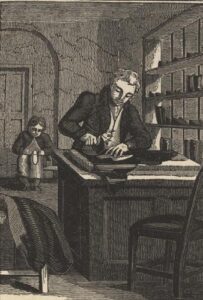
The Shoemaker
Now the shoemaker thought that something about the customer was very strange, and was curious as to where he lived, because he knew everyone in the town, but had never seen this man before, so he decided to follow him, to see where he lived. He set off, keeping a distance so as not to be observed, and was amazed to see his customer go into the graveyard next to the church, and then disappear into one of the graves!
The shoemaker was carrying the awl he used to make his shoes, and, because it was still quite dark, he left the awl on the grave so that he’d know where it was in the daylight. Then he returned when the sun was up with a lot of his neighbours and, taking courage from them, he opened the grave. When he did he found the shoes that he’d made inside the coffin. He probably thought that a dead man could have no use for shoes, so he took them out of the grave, and back home with him.
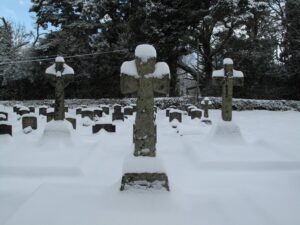
The grave
The next morning he started work before dawn again, and was very busy when suddenly the stranger appeared before him again, and was very angry. The shoemaker was terrified, and all the more so when the stranger told him that he’d not only stolen the shoes that had been paid for, but that he’d made the customer a subject of gossip and wonder by opening his grave, and that the shoemaker would have to pay for this great offence.
So saying, the stranger seized the shoemaker by the arm, and dragged him to the graveyard. Later that day, when the sun had risen, the villagers found the shoemaker’s dismembered corpse on the grave that he’d disturbed on the previous day.
In the past there were many cautionary tales told, to try to deter people from committing crimes. This is a spooky tale probably intended to both entertain people on dark winter nights long before electricity, and to deter people from the dreadful crimes of theft and violating graves!
SAWNEY BEAN
There are a number of Scottish stories about the dreaded cannibal. One of them comes from the coast near Arbroath (not far from where I live), where the coastline is wild and there are a number of caves. It was certainly in print by 1570 that a family of brigands lived in one of the caves, which was called Fiend’s Den. It was said that he used to sneak out and entice children or young men alone to his cave, where he would kill them, and then his family would eat the body. After a while he was discovered and executed for the crime, as was his whole family, except for the youngest daughter, who was only 12 months old. She was brought up by a family in Dundee, but it seems the taste for human flesh was inherited, because when she was an adult, she too was convicted and executed. When she was about to be burnt alive, she informed the crowd that human flesh was so delicious to eat, that if any of the crowd had tried it, they’d never want any other meat either.
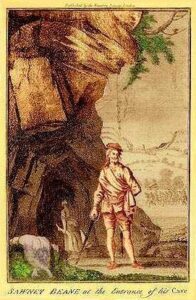
Sawney Bean at the entrance to his cave
This story, which may or may not be true, has probably contributed to the legend of Sawney Bean. He was said to have lived in a cave in the south-west of Scotland, and in common with the tale above, lived with his whole, large family. He was said to rob and kill travellers, who were then cooked and eaten. However, one of the prospective meals succeeded in escaping, and took the authorities to the cave. Stolen goods and money was found there, but also human limbs hung up to dry, and also other human parts that had been pickled. The family was taken to Edinburgh and executed there without the benefit of a trial.
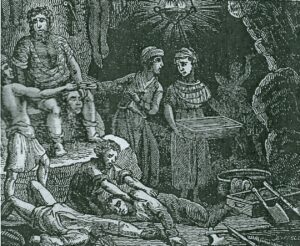
Sawney Bean and his family
There’s no evidence at all that Sawney Bean ever existed, and in fact the story seems to have originated in England rather than Scotland, possibly by Daniel Defoe writing under a pseudonym. He may have been inspired by some mediaeval stories about poor people eating human flesh during famine times. Defoe was an anti-Jacobite, and as the story was published in 1734, it could well have been no more than a piece of anti-Highlander propaganda. Sawney is a short form of Alexander, but ‘auld Sawney’ was also a name for the Devil, and Sawney was also a derogatory term in England for a Scotsman. There were quite a few plays performed in London about Sawney Bean at the beginning of the nineteenth century, but the first telling of the tale by a Scot is not until John Nicholson wrote his Historical and Traditional Tales, in 1843. Wherever it originated, however, it now features in tourist guides of Ayrshire as a gory tale.
A TALE FROM BALLATER
Ballater is about 40 miles away from where I live, so I thought I’d share this tale with you. This particular one wouldn’t have been told round the fire by my MacGregors, because the events are said to have taken place in the nineteenth century. But there are many tales about the same phenomenon, which are much older.
In Ballater there was a family of MacDonalds, who were travellers and lived in a beautiful caravan called the Evening Star. The family consisted of a man, wife and one son, who was already earning money as a trader and hunter by the time he was twelve. One night he’d been out hunting and was tired and a good way from home, when a large coach came along the road, drawn by six white horses. The boy waved to the coach, hoping for a lift, and to his delight it stopped.
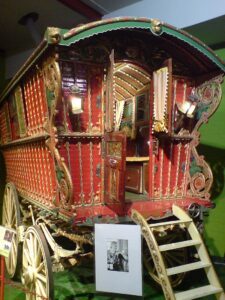
The beautiful caravan (att: By Sunset through the clouds at English Wikipedia, CC BY-SA 3.0, https://commons.wikimedia.org/w/index...)
The coachman was tall and thin, and told the boy that he had to pick up some people along the way, but that the boy could climb up beside him and ride on the outside of the coach if he wanted. The boy agreed, and the coach set off. Along the way they picked up a number of passengers, including an old man, a beautiful girl and a woman in a white gown. The MacDonald boy, being friendly, said good evening to them as they got into the coach, but none of them replied, and none of them spoke to the other passengers or the coachman either.
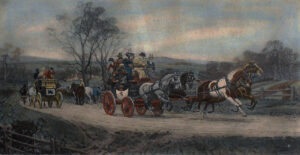
The coach and horses
After a time they stopped at a house, and the coachman said they would have to wait for a while, because he was early, so the boy, who was feeling cold by now, decided to sit inside the coach for a short while to warm up a bit. But when he got in the coach he immediately felt very uncomfortable, because all the passengers were glassy-eyed and silent, which made him think the coachman was maybe on his way to a lunatic asylum with them all. He got out again, and as it was now raining, decided to shelter under the eaves of the house that the coachman had gone into.
While he was there, he looked in the window, to see an old man lying on the bed. A woman and a minister were there too, and the boy heard the minister say that the man had died. The boy’s sadness turned to horror when he saw the coachman walk into the room and wave his hand, whereupon the corpse got up from bed and walked out to the carriage. The boy now realised that the coachman was Death. Death had told the boy that his next stop was in Ballater, where the boy lived, but as he was now terrified, he asked to get out before they reached the village. As he got down, he asked the coachman where the next stop was. The man replied that it was at the Evening Star, and then drove off.
Realising that this was his parents’ caravan, the boy ran as fast as he could to try to warn them, but when he got in sight of it, he could see that it was on fire. He began to cry, thinking he was now surely an orphan, but then saw his mother and father coming to meet him. Relieved, he told them what had happened, and wondered why Death had said he was coming to them, when they were alive. His mother replied that sadly their little dog had died in the fire, so maybe Death had come for him instead.
If you liked these, look out for my next blog, which will feature three more Scottish Folk Tales, about a White Lady, a cave devil, and changelings!
January 27, 2024
The Author’s View: Writing the Jacobite Chronicles Stories.
During the time I’ve been writing the series of back stories about Sarah, Harriet, Caroline and Philippa, Alex and now Anthony, I’ve been asked various questions by readers about how I came to write the stories, the difficulties involved etc. So as Anthony I is published and I prepare to have a few days off before diving into Anthony II (which will probably be the last back story, for now at least), I thought I’d take time to write a blog which will hopefully answer some of the questions I’ve been asked.
When I wrote the Jacobite Chronicles, I had no thought of writing the back stories of any of the characters. After I finished the main series I wanted to go back in time to the start of the whole Jacobite movement, which began at the end of 1688 when James VII/II was pushed off the throne and replaced by William and Mary. During that series I’ll write about Beth’s grandmother Ealasaid, her daughter Ann, Graeme, and maybe a few other characters who feature in the Chronicles.

The Main Series
After Tides I started researching for the new series, Road to Rebellion, which covers a much longer period of time than the Chronicles do, and soon realised that if I was going to make a good job of it, I first had to do a lot of background research. But I couldn’t just leave my loyal readers with no books for a couple of years!
So I put a competition up on Facebook, asking people to tell me which characters they’d like to know more about, and the prize was to feature as a character in one of the books, if I wrote them. The response was incredible, and it was that that led me to draw up a list of potential characters and to start thinking about their backgrounds, with a view to writing a book about each in between researching.

Just a few of my research books!
Once I had the list I realised that I had to re-read the Chronicles and pick out any places where those characters had mentioned events from their past, because their back stories had to match with whatever they’d already revealed. And this was where I hit my major problem. Because, as I said, I had never thought to write back stories, so the things that Sarah, Alex and Anthony had revealed didn’t always fit in with my shiny new ideas for their back stories, and sometimes there was a considerable amount of wailing and gnashing of teeth as I tried to work out how to incorporate a throwaway comment from the main series into their now increasingly detailed past stories.
It was a bit like doing a jigsaw puzzle in which you have to incorporate pieces from a different puzzle and somehow make them fit. Sometimes it was fun, sometimes it was challenging, and sometimes I spent days miserably throwing away great ideas and wishing my character in Hell for saying such a stupid thing in book three. I initially thought Harriet’s book would be easier, because she only has two tiny scenes in the Chronicles, and apart from being Caroline’s aunt, her past is hardly mentioned. But when I decided to incorporate Highbury’s story into Harriet’s, and continue it into Caroline and Philippa’s, all that changed, and those books suddenly became incredibly complicated.
Although writing the back stories was comforting in a way, because some of the characters were already old friends, I also had to invent a whole load of new characters, some major, some minor, and also incorporate the competition winners, giving them cameo scenes in the books. At first I was a bit worried about this, but it turned out to be one of the most rewarding parts of writing the books! I decided to contact each winner and ask them to tell me a little about themselves, their appearance, likes and dislikes, hobbies, professions, dreams etc, which I would then weave into the book versions of them as I wrote. This was great fun, as I got to know a lot more about some readers who I’d not known at all before then, and establish relationships with them!
It was also fun exploring places and relationships between all social classes of people in some depth, from the very poor to the wealthy. This involved a lot more research, but was great fun. In the Chronicles I tend to focus more on the Scottish Highlanders and the English nobility, with a few scattered characters outside those spheres, but the back stories take me all over the place, which has been fascinating.

The Jacobite Chronicles Stories covers (plus novella)
I just wanted to add a little about my covers. Because I’m self-published I’m responsible for designing my own covers. Which is wonderful in one respect, as I can make them relevant to the actual book content, and absolutely terrifying in another respect, as I have the artistic skills of a five-year-old. I can often see what I want in my head, but am completely incapable of drawing it. Luckily I have a phenomenal cover artist who is fully capable of taking my stick-figure sketches and written descriptions and turning them into my dream covers!
Having said that, it still involves a lot of work for me, and sometimes a lot of messing about for both of us, to get it just right. In the Chronicles the basic layout for the series is people at the top blending into scenery of some relevant sort below. In the Stories I decided I wanted the character to the left in the foreground, with relevant scenery behind. Every book in the series would have this basic pattern.

The background is the river view near my house.
Then I came to Alex and Anthony, which were both challenging! The main figure of Alex is Jason Tobias, the model and actor who posed for the Chronicles pictures, but I just couldn’t find the right background! So it ended up as a mix of a Scottish scene with added heather, a photo I took of a Highland cottage from the Highland Folk Museum (well worth a visit), and two little boys at the beach dramatically altered by my cover artist to become the young Alex and Duncan. I love that cover now it’s finished, but it was a nightmare to construct.

Multiple aspects to this cover!
Not as much of a nightmare as Anthony though. Initially I thought Anthony would be one book, so managed to find the perfect background, and have Najla (cover artist) drop a few figures into it. Lots of time spent researching, but worth it. However, I couldn’t find any pictures that were even vaguely like Anthony! In despair I managed to get a friend of a friend, Richard, to agree to pose for it on a visit from Wales, and then bought a wig, gloves etc, and paid for a local seamstress to make a basic 18th century frockcoat for me. The end result was fabulous.
But then I realised Anthony would have to be two books, so all of a sudden I had another cover to do, in which Alex would be somewhere between the Highlander and the baronet. I found a lovely background picture which would fit in with him as a student (after a little tinkering to remove modern accessories), but my previous model was no longer available. Luckily my electrician Tim, who is a great sport and now a friend, and also the right height and build, agreed to have a break from doing electrics for me and instead don a frockcoat and wig and adopt assorted silly poses in the garden, with much laughter. The result is Anthony Part I’s cover, which is one of my favourites!
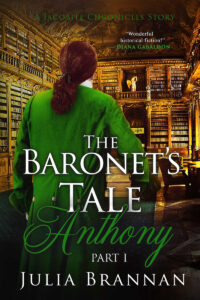
My latest cover, and now one of my favourites.
As the books have come out and my readers have finished them, I’ve had a lot of feedback saying that the back stories made them feel much closer to my characters, and many of you have re-read the main series with new eyes. While I haven’t re-read the main series in that way, it’s certainly brought me a lot closer to my characters as well, and, although I’m really looking forward to starting my new series once Anthony II is written, (I have done a lot of the research for it now, although I’ll have to refresh myself on it), I’m also dreading it, because these characters have lived with me almost constantly for over ten years, and I’ll miss them dreadfully when I finally have to say goodbye to them and move on to new pastures, as it were.
So there’s a part of me that doesn’t want to finish Anthony II, as I think I’m going to find it very difficult to let everyone go, some characters more than others. When I started writing years ago I never imagined being as involved with my characters as I’ve become. It’s a heady, wonderful feeling! But also a sad one, as the series starts to come to an end. I may at some point write more back stories – Iain and Maggie, and possibly Gabriel’s stories are possibilities, but not immediately. I’m sure the new characters will become friends too, but there will always be a place in my heart for the MacGregors, and all the other characters I’ve grown to love dearly. I hope that’ll be the case for you, too, as my readers!
May 15, 2022
Holyroodhouse
In my previous blogs about Edinburgh I’ve mentioned Holyroodhouse in passing, but it’s well worth a blog of its own, so here goes! The Palace of Holyroodhouse is situated at […]
The post Holyroodhouse appeared first on Julia Brannan.
April 15, 2022
Edinburgh Castle
Anyone who has ever visited Edinburgh will have seen Edinburgh Castle. It’s impossible to avoid, standing majestically as it does above the city, perched on Castle Rock. It’s glorious, and […]
The post Edinburgh Castle appeared first on Julia Brannan.
March 15, 2022
A history of Edinburgh – eighteenth century to present day
In last month’s blog I looked at the history of Edinburgh from early times, until the early 18th century, when I have Alexander MacGregor showing his two young sons the […]
The post A history of Edinburgh – eighteenth century to present day appeared first on Julia Brannan.
February 15, 2022
History of Edinburgh – early times to the 1700s
The city of Edinburgh features in The Highlander’s Tale: Alex, and I hopefully managed to give readers a flavour of eighteenth-century Edinburgh, but I thought it was time to write […]
The post History of Edinburgh – early times to the 1700s appeared first on Julia Brannan.
January 15, 2022
Clan Gregor – The Jacobite Connection
For reasons I talked about in my last blog, although all Highlanders were considered to be formidable warriors, Clan Gregor was particularly renowned both for its ferocity and eagerness to […]
The post Clan Gregor – The Jacobite Connection appeared first on Julia Brannan.



